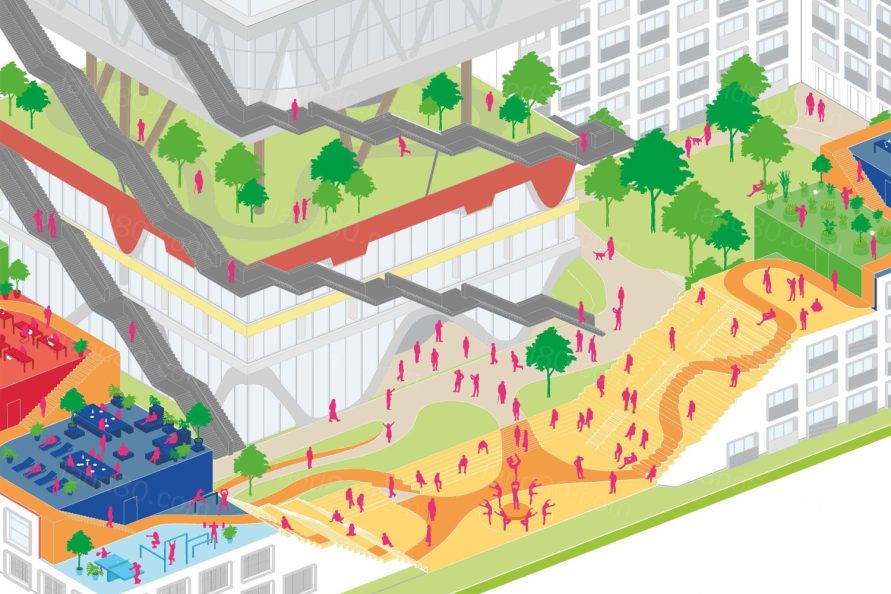MVRDV于今日发布了他们自己的一个开创性项目:2000年德国汉诺威世博会荷兰馆改造设计,这个项目将原有的世博会荷兰馆变成一个联合办公大楼,并且在荷兰馆的周围增加两个新建筑,一个是学生宿舍,另一个是办公室和停车场。MVRDV的设计保留了2000年世博会展馆的特色, 2000年世博会荷兰馆的标志之一——三层森林,并重新诠释了新建筑的概念。
MVRDV is today revealing its design to transform one of their own seminal projects from the practice’s early years, the Dutch Pavilion at the 2000 World Expo in Hannover. The transformation will convert the former Expo Pavilion into a co-working office building, and two new buildings will be added on the space surrounding the pavilion, one containing student housing and the other hosting offices and parking. MVRDV’s design maintains the qualities – including the forest on the 3rd floor – that made the pavilion an icon of the 2000 World Expo and reinterprets the original project’s concept for the two new buildings.

原来的荷兰馆的设计呼应了荷兰馆的主题“荷兰创造空间”, 6个景观的空间并未占据整个场地,而是集中在一栋大楼上,而其余部分则成为世博会场地的户外开放空间。对一个以土地匮乏为特征的国家而言,展馆传递着一种解放的信息,那就是自然可以被人为创造,并且可以垂直堆叠。这是可持续发展设计的重要参考依据,表现出理想的建筑作为一个独立的生态系统,与自然相结合,产生自身内部资源循环。
The design of the original Expo 2000 pavilion was a response to the Dutch theme for the Expo, “Holland Creates Space”. Instead of occupying the full site, six Dutch landscapes were stacked into a tower on one portion of the site, while the remainder of the area became an open outdoor space within the Expo grounds. The pavilion stole the show; for a country defined by its lack of land, the pavilion conveyed the liberating message that nature can be created artificially and stacked vertically. It became a key reference for sustainable design, presenting an ideal of a building as a selfcontained ecosystem, incorporating nature and generating its own internal resource cycles.
▼项目概念 Program concept per level

▼三个建筑整合 3 Buildings

项目保留了“层叠景观”的概念,翻新了已有的建筑,并在原有场地的周围增加了两个阶梯建筑。改造后的展馆将容纳办公室和会议室,特别注重保留原有的设计特色,并将其转化为办公元素。例如,第一层原本是一个格子式的温室,以严格的直线式布局作为办公室,而第二层的的种植空间则用玻璃分隔开,可以转化为会议室和办公空间。其它保留下来的建筑有森林的层面和外部的楼梯;底层的“沙丘”将作为小咖啡馆和展览区域的交汇点,而原来的圆顶空间则变成了一个快餐餐厅。
The current project maintains this “stacked landscape” concept, renovating the existing building and adding two stepped buildings on the perimeter of the original site. The renovated pavilion will house co-working offices and meeting rooms, with particular attention given to maintaining the features of the original design and converting them into office elements. For example the 1st floor, which originally housed a grid of greenhouses, will keep its strict rectilinear layout as an office, while the pods on the 2nd floor – originally planters – will be glazed and converted into meeting rooms and office spaces. Other features that will be retained are the forest level and the exterior staircases; the ground-level “dunes” will be retained as a meeting point with small cafés and exhibition areas, and the rooftop dome that was formerly home to a restaurant will now host a new fast-casual restaurant.
▼广场空间 Plaza zoom

▼步行系统与办公室 Stepstory Mikro and Office

▼步行层与景观凉亭 Stepstory Pavilion

新增的建筑用作学生宿舍、办公室和停车场(小楼中),它们构成了场地周围的周边街区,并在场地的西面创造了一个入口空间,为整个中心的景观庭院提供了入口。根据叠层景观的概念,新建筑的阶梯屋顶将形成一系列色彩丰富易于到达的平台,每个平台都有不同的功能,从花园、运动场到研究区和电影院。这个平台通过一个彩色的表面连接起来,像一条带子一样延伸到新的体块上,定义了用途和空间。高透明度的玻璃被用来保持展馆设计的开放性和透明性,使其与新的立面相结合。
The two new buildings add student housing (in the larger building) with offices and parking (in the smaller building). These form perimeter blocks around the site, stepping down to create an entry point on the west of the site that provides access to the landscaped courtyard in the centre of the ensemble. In a twist on the concept of stacked landscapes, the new buildings’ stepped roofs will form a series of colourful, accessible terraces with a different function on each terrace, from gardens and sports facilities to study areas and a cinema. These terraces are linked together by a coloured surface that extends like a ribbon over the new volumes, defining uses and spaces. Where new facades are required to enclose the pavilion, high-transparency glass is used to maintain the design’s open and transparent character.

项目被认为是可持续建筑的标志之一,也是在建筑环境中加入自然元素的建筑之一,还将作为现有结构重新使用的展示平台,展示建筑在设计时如何考虑到未来的适应性。
This new phase of the Expo Pavilion’s story builds on the building’s reputation as an important reference for sustainable architecture. Not only will the forest level remain an exemplary instance of natural elements added to the built environment, it will also become a showcase for the reuse of existing structures, showing how buildings can be designed with future adaptations in mind.

项目名称:Expo Pavilion 2.0
设计单位:MVRDV
合作单位:AI + P Planungs GmbH
项目位置:德国 汉诺威
项目年限:2020
项目客户:iLive Expo Campus GmbH
项目规模:展馆建筑——6,300m2办公和共用 / 新建筑——18,900平方米的学生宿舍,办公室,停车场
设计负责人:Jacob van Rijs
项目总监:Sven Thorissen, Markus Nagler
设计团队:Katrien van Dijk, Enrico Pintabona, Philipp Kramer, Daniel Mayer, Rico van de Gevel, Luca Vacchini, Mateusz Wojcieszek, Andrea Manente, Saskia Kok, Evgenia Zioga, Pietro Marziali, Bartlomej Markowski, Cristina Marginean, Philipp Wenzl, Alessio Palmieri, Anna Brockoff, Alexander Forsch, Katarzyna Plonka, Anna Bern, Ruggero Buffo, Quinten Smits, Antonie van Vliet Visualisations: Antonio Luca Coco, Pavlos Ventouris, Francesco Vitale, Magda Bykowska
图片来源:©MVRDV
Project Name: Expo Pavilion 2.0
Architect: MVRDV
Co-architect: AI+P Planungs GmbH
Location: Hanover, Germany
Year: 2020
Client: iLive Expo Campus GmbH
Size and Programme: Pavilion building: 6,300m2 office and coworking; New buildings: 18,900m2 student housing, offices, parking
Founding Partner in charge: Jacob van Rijs
Director: Sven Thorissen, Markus Nagler
Design Team: Katrien van Dijk, Enrico Pintabona, Philipp Kramer, Daniel Mayer, Rico van de Gevel, Luca Vacchini, Mateusz Wojcieszek, Andrea Manente, Saskia Kok, Evgenia Zioga, Pietro Marziali, Bartlomej Markowski, Cristina Marginean, Philipp Wenzl, Alessio Palmieri, Anna Brockoff, Alexander Forsch, Katarzyna Plonka, Anna Bern, Ruggero Buffo, Quinten Smits, Antonie van Vliet Visualisations: Antonio Luca Coco, Pavlos Ventouris, Francesco Vitale, Magda Bykowska
Images: © MVRDV
|